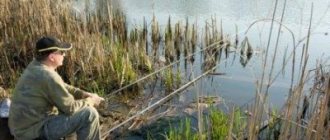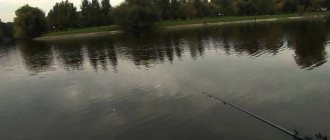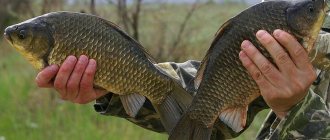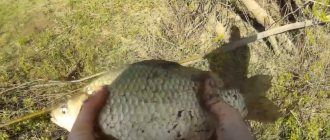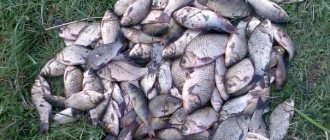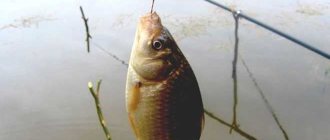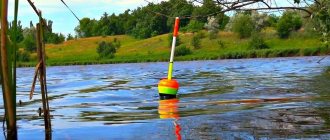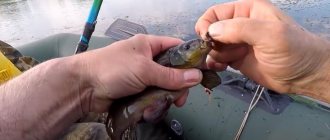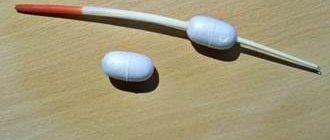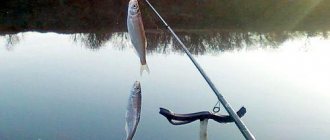In addition, catching crucian carp with a float rod is quite a gambling and exciting activity. As a rule, if a crucian carp bites, it bites actively, just have time to cast the fishing rod. This article talks about how crucian carp behave in the summer, what they eat, where they prefer to be and what bait they like.
As a rule, the same fish behaves differently at different times of the year. This is due to the fact that seasonally it constantly changes its gastronomic preferences, as well as its parking places on the reservoir, depending on the availability of food supply. Experienced fishermen, before going fishing, study weather conditions that seriously affect the behavior of fish. Moreover, they know how fish behave in certain conditions. That is why experienced fishermen always return home with a catch.
Catching crucian carp in the summer with a float rod occupies a special place in their lives for many anglers. It’s not for nothing that they are all simply called “crucian carp fishermen,” since all their lives they do what they do: catch crucian carp. This “narrow” specialization allows us to study the behavior of this fish in detail. Moreover, they know what gear and when is best to catch crucian carp. Despite this, almost all of them use a regular float rod. This tackle is not only simple, it is also quite effective in the right hands.
In addition, catching crucian carp with a float rod is quite a gambling and exciting activity. As a rule, if a crucian carp bites, it bites actively, just have time to cast the fishing rod. This article talks about how crucian carp behave in the summer, what they eat, where they prefer to be and what bait they like.
This manipulation makes it possible to transmit the slightest touch of the fish to the bait to the float and, on the preconditions for swallowing the bait, the fisherman can hook it. The arrangement of the weight in the form of a garland prevents the equipment from tangling during casting and allows you to more accurately position the float in the water column, providing a clear visual transmission of the bite.
Choosing a rod for different fishing conditions
Float tackle for crucian carp can be formed on the basis of various types of rods. Bolognese, fly and plug types of fishing rods are the most suitable options for equipment for catching crucian carp on a float rod. The main criteria when choosing gear will be the characteristics of the reservoir. The parameters of the criteria are the intensity of algae overgrowing of the bottom base, the distance of promising places from the casting point and the conditions of placement on the coastline, which affect the convenience of supplying equipment.
A fly fishing rod for crucian carp is the most acceptable option, which in most cases will meet the fishing requirements both in terms of distance from the shore and reliability of equipment, based on the size of the fish. For fishing, medium weight and tested fishing rods are selected, in telescopic and plug-in versions, with a length of four to six meters. This rod will allow you to fish in the coastal zone, 5-10 meters from the shore. In this case, the shore of the reservoir must be free of trees and other obstacles that interfere with casting.
A fishing rod for catching crucian carp with a float, selected according to these recommendations, will significantly improve the accuracy of casting and will allow you to balance feeding fish with fishing in a narrow fishing area limited by the rigid dimensions of the feeding table.
Crucian carp is one of the most intelligent and fastidious fish. He is very shy and reacts sensitively to sounds, smells, and even color. Crucian carp are also whimsical and rather capricious when it comes to bait. Crucian carp can walk around the bush for a long time, try the bait, savor it, but never bite. It is also quite natural for him to catch one bait one day, and then avoid it the next day.
Peculiarities of crucian carp biting on a float
Fishing for crucian carp using float gear is best from mid-spring. If it is early and the weather is warm like spring, then in April the crucian carp will begin to bite well. If the winter is long and the snow lasts almost until the end of March, then crucian carp fishing will become more intense only towards the end of spring.
It is of no small importance on which body of water you catch crucian carp in the spring with a fishing rod. In a deep lake, even in early spring, the water will not warm up soon. In small bodies of water, carp fishing begins much earlier, since in shallow water the water warms up quite quickly.
In spring, crucian carp most often lives at shallow depths, in particular in coastal areas where reeds or algae grow. The water temperature in such places is much higher than at depth, and there is a greater chance of finding something to eat. Therefore, in the spring, fishing for this fish is better with float gear.
Crucian carp very often changes its habitat in the spring. Schools of crucian carp are in constant motion and can move throughout the entire reservoir. Therefore, having caught a big catch in one place, this is not a guarantee that the place has been baited, and tomorrow the bite will also be good here.
Where to catch crucian carp in summer
This fish is very common in almost any body of water. First of all, it’s worth figuring out where it’s best to look for crucian carp in a pond. Crucian carp is a fish that constantly moves around the area during the day, hiding from the heat, for this reason the best place on a reservoir for catching crucian carp in the summer with a float rod is near the coastline.
It is here that crucian carp loves to walk in the shade of growing trees and in dense coastal vegetation. Thanks to such places, crucian carp can bite at one point until sunset. It is also worth knowing that in places where there is blooming water, crucian carp cannot be caught, as it tries to avoid such places due to a lack of oxygen. It is worth knowing that crucian carp spawns once, and all the time before spawning and after spawning, it has a very active diet.
For this reason, it is better to abandon the inertial reel in those reservoirs where carp coexist with crucian carp. He can always bite, even on pieces of worms intended for crucian carp no larger than a palm. If this happens, the fishing line without the shock-absorbing properties of the clutch will instantly tighten and break like a string, since the angler will not have time to let go of it.
What is better to put on the hook of a float rod?
In crucian carp fishing with a float, various baits, both animal and plant origin, can be used. The bait is selected depending on how warm the water in the pond is. In cold water after recent ice, crucian carp need protein, which is found in representatives of the animal world. Therefore, in early spring, crucian carp will be better off biting on worms, bloodworms and maggots. As the water warms, you can use bait made from plant components. Dough, which is prepared from ingredients such as pea, corn or semolina, is on the list of favorite dishes for crucian carp in the spring.
The choice of bait also largely depends on the presence of other fish in the reservoir. And if the worm is used in all types of reservoirs, then you need to be careful with maggots and bloodworms. If there are some other small fish in the lake and pond, it is possible that they will not constantly eat the bait, thereby interfering with a good crucian bite.
You can't go wrong if you take several different types of bait with you on your fishing trip. Crucian carp is such a capricious fish that its appetites can change throughout the entire fishing period.
Despite the fact that crucian carp is a very common fish, only a fisherman who knows well how to catch crucian carp in the spring with a fishing rod and successfully selects a fishing spot, food and bait can boast of an excellent catch .
Happy fishing!
Catching crucian carp with a float rod in the spring (video)
Catching crucian carp in spring with a float rod (video)
Crucian carp on a fishing rod in spring: video
Equipment of a float rod for crucian carp
Beginners often ask the question: how to equip a crucian lapdog? The equipment of a float rod for crucian carp includes several carefully selected elements, namely:
[THERE IS AN ANSWER] Which fishing rod is best for carp fishing
- fishing lines;
- float;
- leash;
- weight;
- hook.
Crucian carp fishermen constantly argue about the leash. Some say that it is impossible to fish without it, others do not see any need for it. Crucian carp is not a timid fish; you won’t scare it with a thick fishing line. Meanwhile, a leash can help out if a fish that is too heavy to lift sits on the hook. In this case, only a small piece of thin fishing line and a hook will be lost, and not the entire equipment. The downside of the leash is the additional knots, which are known to reduce the reliability of the gear.
Buying the most expensive hooks does not guarantee one hundred percent results, so you should not focus on price. First of all, you should pay attention to the shape, thickness and quality of the material. A reliable product has the correct hardening, which can be checked by lightly pressing its tip with your finger. With a good hook, it will resist elastically, and if you let go, it will immediately return to its previous position.
Experienced crucian fishermen, having tried many bait options, recommend the following:
Features of fishing with a float rod
At shallow depths, the best results will be achieved with a slowly falling float rod rig. In such a rig, only the float is surrounded. Thanks to this trick, the bait slowly falls in the water column. Resembling natural food. Another plus is that the bait does not sink into the mud. It will be more catchy to use such equipment in the wind using a jig.
The float will rise up and down on the waves, at the same time raising and lowering the jig. With this method, it is important to correctly set the depth at which the jig will touch the bottom and create a small spot of turbidity. Fishing will be more successful if you add an animal bait to the jig. Accurate bait casting is important. If you throw bait in different places, you will not be able to collect fish at one fishing point, which will significantly reduce the likelihood of a large catch.
If the fishing point is located at a considerable distance from the shore, you can use a bait slingshot to deliver the bait. Match fishing is more effective in places where there is no vegetation nearby, since it is more difficult to control the direction of movement of the fish after the bite. If fishing is done with a fly rod, the best place will be areas protected from the wind. When using such a fishing rod, it is important to quickly remove the caught fish from the water so that the noise does not scare away the inhabitants of the reservoir who responded to the bait at the fishing point. Fishing with a fishing rod with a side nod is no less effective. This method can be used to fish not only from the shore, but also from a boat. The peculiarity of this method is that with a tackle with a side nod it is possible to fish windows in aquatic vegetation and duckweed.
Catching crucian carp with a fishing rod and the role of camouflage
If in the spring this bumpkin is quite bold, at least not timid, then the crucian carp behaves differently in the summer, and this is the main difference between summer fishing and spring fishing.
In summer, camouflage is simply necessary at all times, otherwise fishing will not be successful, many crucian fishermen have been convinced of this more than once or twice. If the fish is not far from the shore (which is a common occurrence in summer), then even when approaching the water’s edge, you can ruin your fishing - you can scare off the school, and then heroically overcome difficulties for a long time, pulling the fish back with bait to the float casting distance.
Therefore, you need to move as silently as possible, trying not to come close to the coastline at all. You need to be located about a meter from the water's edge, not closer.
A six-meter fly rod is ideal for this kind of fishing. During the fishing process, you should try not to make sudden movements, this is what can scare off the cautious crucian carp. For the same reason, casts must be performed smoothly, and if this does not work, then it is worth using heavier equipment so as not to sharply cut through the air when casting.
[THERE IS AN ANSWER] What smells does carp like in summer?
When fishing, you need to try to immediately move the trophy at least a little away from the bait point and not miss a single fish. Skilled floaters claim that when a flock is preoccupied with absorbing food, it does not pay much attention to the disappearance of its fellows, but if a crucian carp managed to escape from the hook of a fishing rod, it causes a strong commotion in the entire flock, and it can leave this dangerous area for a long time.
But if, nevertheless, the crucian carp managed to get off the tackle, then it is advisable to let the “place calm down” and move to a spare area, and you should return back no earlier than an hour later.
By the way, the degree of caution of crucian carp largely depends on the wind. When there is calm, crucian carp are extremely careful, and the bites are timid, fortunately they are clearly visible in the absence of ripples in the water. But when the breeze blows, the crucian carp becomes bolder and forgives the angler some mistakes in fishing and camouflage.
Probably the most ancient fishing tackle. In various modifications it is used by fishermen of all ages, professions and even gender.
The fly fishing rod, among other things, has a thin rig, which allows you to successfully catch cautious fish, and the flexible tip and the rubber shock absorber enclosed in it help to catch large specimens.
This tackle is a real heavy artillery in the arsenal of float tackle and it serves for particularly long-range casts, which can reach 30-40 meters. Therefore, special waggler-type floats are 30 cm or more in length, and the load reaches 15-20 grams along with weights on the fishing line. Wagler floats can be loaded, depending on fishing conditions, with shot in the float body and washers, which are screwed on as needed.
Any of these rods is suitable for catching fish such as crucian carp.
Catching techniques for float fishing for crucian carp
To successfully catch crucian carp, you can practice various catching techniques, depending on the type of gear chosen.
Flywheel
A fly rod is one of the most common gear for catching crucian carp; it has the following features:
- There are no guide rings on the rod, and the reel is excluded from the equipment.
- The blind equipment is installed; to fasten the working line, the tip of the rod is equipped with a special connector.
- The length of a rod designed for catching crucian carp is usually about 5-6 meters.
- This kind of gear is used most often during spring fishing, since the features of the equipment exclude the possibility of making long casts.
Plug
Plug tackle is one of the types of float rods used for catching crucian carp; This option has the following features:
- The design features of the rod allow you to add or remove knees, so this rod can be adjusted to different fishing conditions.
- Unlike a number of other varieties, plug fishing rods work well with thin fishing line and lightweight float models, which allows you to make long casts of bait without losing their accuracy.
Match
Another type of tackle is match fishing rods, which have the following distinctive features:
- Match fishing rods can be equipped with various rigging options, but it is recommended to use only sliding type floats.
- Such gear is most often used in early spring, as it is effective when catching fish that behave cautiously. In general, a match fishing rod cannot be called a good choice if the main prey is crucian carp; Today this variety is not in great demand.
Bologna
Bolognese fishing rods are telescopic gear, the length of which can vary from 4 to 8 meters; their other features are as follows:
- It is possible to install blind equipment or use a sliding leash; depending on this, the fishing rod is equipped with a spinning or inertial type reel, respectively.
- The equipment should be as light as possible, so for Bolognese fishing rods, a fishing line with a diameter of no more than 0.12-0.14 mm is usually used.
- The main advantage of this variety is the versatility of the gear: it can be used for catching crucian carp near the coastline and in shallow water, as well as for making long casts.
Fishing process, fishing recommendations
Before we begin our review of the features of crucian carp fishing, let's watch a video that illustrates and narrates some of the features of life and its fishing.
The main thing in catching crucian carp is good camouflage of the fisherman on the shore. Maximum silence must be observed. It is advisable to fish while sitting and, if possible, not move along the shore.
The cast should be as quiet as possible. The bait should be on the bottom. The bite of crucian carp largely depends on the reservoir. Crucian carp can drown the float, lead it or “lay it out”. It’s not worth hooking immediately. You need to mentally count to three and only then make the hook.
When fishing for crucian carp, you should immediately move it away from possible shelter and only after that, slowly land the fish.
Above is brief information about catching crucian carp using a float rod. In reality, fishing cannot be built on the use of templates. You need to look for your own special approach to catching crucian carp in each specific body of water. This is the only way to be sure of a constant, serious catch of this fish.
Crucian carp can be found in any body of water in which other species of fish cannot exist. This is the reason to assert that catching crucian carp is quite simple and does not require certain knowledge of its behavior at any time of the year, with the exception of the winter period. This statement applies to small lakes and ponds that are oversaturated with small crucian carp. To catch a decent specimen, you will have to work a little, studying the behavior of crucian carp.
Secrets of catching crucian carp
To summarize, we can highlight a number of secrets and tricks that allow you to get a good catch when fishing for crucian carp:
- Aromatic additives can be used not only in bait mixtures, but also to treat baits with them. The bait must have a stronger odor, otherwise it will not attract the attention of the prey.
- The start of fishing should be preceded by studying the reservoir, including searching for underwater keys and determining its type. In closed reservoirs, crucian carp usually exhibit more finicky behavior.
- Crucian carp always look for food near the bottom surface; this feature of its behavior must be taken into account to ensure correct loading of the equipment.
- You can scatter light river sand at the place chosen for casting; it will color the surface of the bottom in the appropriate color, which often attracts crucian carp.
Peculiarities of behavior of summer crucian carp
Crucian carp is a rather capricious type of fish. It should be noted that fishing for crucian carp on a lake or in another body of water with standing water differs from the process of fishing on large and small rivers. Fishing for crucian carp in the summer with a float rod is very popular and with the appropriate equipment and the right choice of fishing location, you can catch decent-sized crucian carp.
[THERE IS AN ANSWER] How to equip a bottom fishing rod with a feeder
During the summer, crucian carp behave differently. After spawning, it is advisable to look for it near coastal thickets of reeds, water lilies or other aquatic vegetation. At the end of August, when the vegetation begins to wither, the crucian carp looks for deeper places. At this time, it is advisable to look for it in holes or make long casts to depth.
Such a device will have the greatest sensitivity in this situation. Thanks to this, the fish will be able to see even a minimal bite. The float will offer virtually no resistance when moving in the water, so the reaction to swallowing the bait will be visible immediately.
Float equipment
The lightest materials with suitable strength indicators are used as raw materials for the manufacture of the float body. The most commonly used materials are balsa and foam. Polyurethane foam is used less often. Such raw materials make it possible to provide additional strength due to minimal residual deformation. Even if a fisherman accidentally steps on the float, the functionality will not be damaged in any way.
According to their configuration, floats are divided into the following types:
Olive. It is a universal form, as it can be used for catching crucian carp in still water and in the current. Weight can vary from 0.5 to 6 g depending on the scope of use and casting depth.
When choosing a particular type of float, you need to carefully study the characteristics of each type.
An earthworm or dung worm is a universal bait for catching crucian carp, especially in spring. And in the summer, baits of plant origin are considered the best:
Baits and lures
An earthworm or dung worm is a universal bait for catching crucian carp, especially in spring. And in the summer, baits of plant origin are considered the best:
- pearl barley
- corn
- green pea
- dough
- crumb of bread
- boilies are not large
As already mentioned, the worm can be called a universal bait, and if the crucian carp sometimes does not want to peck at the maggot, then it almost always prefers the worm.
It is known that crucian carp loves standing and calm water. But even in ponds there are places with running water, so it is better to fish in small creeks or bays; there is a high probability that crucian carp will feed here.
For a good bite, you need to take a responsible approach to the choice of bait and attachment, as well as correctly assemble the equipment.
